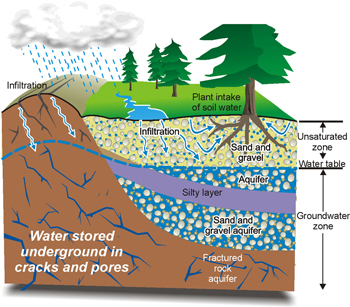What is ‘Safe Groundwater Yield’?
What is ‘Safe Groundwater Yield’?
What is this concept?
 Safe yield of a groundwater basin or aquifer system is defined as the amount of water that can be withdrawn from it without producing an undesired effect (Todd, 1959).
Safe yield of a groundwater basin or aquifer system is defined as the amount of water that can be withdrawn from it without producing an undesired effect (Todd, 1959).
Undesired effects can manifest as:
- Reduced discharge of groundwater to surface water features
- Reduction in ecological base flows
- Overlapping of drawdown cones
- Depletion of reserves
- Land subsidence due to pore pressure reduction
As a result, withdrawal of water from aquifers must be managed to ensure that such negative effects do not occur.
A considerable amount of groundwater resides beneath the province, and a significant amount of water recharges the system annually. However, in keeping with the concept of “safe yield”, only a fraction of that water can be safely used in support of human activities, while maintaining ecological and environmental integrity of our basins. This amount is highly dependent on how, where and when our groundwater resources are developed.
Under natural conditions, aquifers are in a state of dynamic equilibrium with the volume of recharge equal to the volume of groundwater discharge to streams. However, these rates will vary in response to climatic changes, and thus vary seasonally.
Artificial stresses placed on shallow groundwater systems from groundwater abstraction, or deeper systems by oil and gas extraction or waste injection can also have significant effects throughout a basin if pressure effects are transmitted to otherwise discrete intervals or open pathways for fluid transfer exist (faults). That said, some reduction in groundwater discharge can occur without causing adverse effects over the short or long term.
A sustainable groundwater yield for an aquifer is considered here to fall within the range of natural groundwater discharge during the baseflow season and the higher discharge that occurs during the spring freshet and later season precipitation events.
How is it applied?

Currently in Alberta, the concept of safe yield is embodied in Alberta Environment’s Groundwater Evaluation Guideline (AENV 2003). Pursuant to the guideline, applicants for a licence to pump groundwater (outside of the statutory limits) are required to adequately understand the groundwater environment they are planning to develop and must assess the Q20 of the supply interval, that is, the 20- year long-term yield. This is currently assessed using standard methods of analysis (Farvolden Method or the Moell Method – where large drawdown occurs in a well at the beginning of an aquifer test).
The Groundwater Evaluation Guideline is designed to restrict the magnitude of drawdown in a pumping well to a certain amount of its available head. Differing definitions of available head apply for confined and unconfined aquifers.
In the case of confined aquifers, available head is defined as the distance between the non-pumping water level and the top of the aquifer interval or well completion interval, whichever is less. For unconfined aquifers, available head is defined as 2/3 of the distance between the base of the aquifer and the non-pumping water level (or 2/3 or the saturated thickness). The methods of analysis applied are currently accepted as protective enough of the aquifers themselves; however, provisions are included in the guideline to ensure that effects to other water users, water bodies and the aquatic environment are properly understood, managed and do not cause an unreasonable impact.
An additional `safe yield` guideline exists in Alberta, which applies to oil companies that use water for the purpose of oilfield injection for enhanced oil recovery (waterfloods) and water that has been used to generate steam for injection in support of in situ thermal oil recovery. The Water Conservation and Allocation Guideline for Oilfield Injection (AENV 2006) effectively limits the amount of drawdown that can occur within a certain radial distance of the active pumping well (150 metres) to 35% of the available head within the first year of operation, and 50% over the life of the project. Monitoring is typically required to confirm projections, and stipulations are often made in approvals to address adverse impact to groundwater dependant ecosystems or other nearby water users.
Are there other ways to determine safe yield?
Other useful means of assessing and possibly establishing a safe yield for an aquifer is to conduct computer modelling to assess potential future effects from a groundwater diversion. Model results must be verified by actual measured values obtained from monitoring wells to ensure that the model is adequately forecasting effects. Using such decision-support tools, stipulations can be placed on drawdown effects to nearby users (less than 10% impact on available head), or limits on how much baseflow contributions to nearby streams, rivers, lakes or wetlands may be reduced (no more than 5% of groundwater discharge flux).
Assessing the latter of these two effects can be very complicated, as the impacts from natural hydrologic fluctuations in response to climate variability can sometimes mask the effects of human activities. As such, having a good understanding of the range of natural variability, and ways of detecting departures from well-established trends, is paramount to protecting surface environments from unintended consequences.
Section 4: Age, Trends, and Yield
Module 1: How old is our groundwater?
Module 2: Groundwater Levels and Temporal Trends
Module 3: What is Safe Groundwater Yield?
